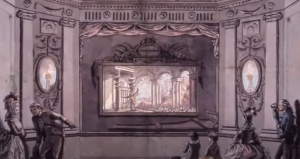Halsewell Tragedy a National Disaster
On Monday 6th March 1786 the Times newspaper carried an advertisement for a presentation from Mr LOUTHERBOURGH’S EIDOPHUSIKON, Describing the catastrophe of the HALSEWELL EAST INDIAMAN.
This was the first ever disaster movie, it only lasted 15 minutes but, it became a London sensation and it was shown 50 years before the invention of photography.
Eidophusikon
The loss of the Halsewell was a national disaster and manifested itself in various avenues. For instance, on Monday 6th March 1786 the Times newspaper carried an advertisement for a presentation from Mr LOUTHERBOURGH’S EIDOPHUSIKON, describing the awful and pathetic Scene of the STORM and SHIPWRECK, Conveying a very Striking Idea of the late dreadful Catastrophe of the HALSEWELL EAST INDIAMAN 42.
At the Exhibition Rooms over The Exeter Change, Strand, London.
The show was a glamorous unique theatre which seated around 130 people paying three to five shillings each. It comprised of a miniature stage about two metres wide, one metre high and 2.7 metre deep. On the stage painted five scenes from the disaster’s transition, each three minutes long, using controlled lighting, magic lantern slides, coloured silk filters, clockwork automata, three dimensional models, painted transparencies and an accompanying sound system.
This was the first ever disaster movie, it only lasted 15 minutes but, it became a London sensation and it was shown 50 years before the invention of photography.
George III Visits Wreck Site
In the summer of 1789, King George III, his Queen and the three eldest princesses arrived at Weymouth for a two and half month holiday. They enjoyed trips to the to a frigate anchored for the purpose in Weymouth Bay and played card parties and attended plays in the evening from the King’s favourite actress. The King and Queen also celebrated their 28th wedding anniversary with a ball 43.
However, there was a more serious reason. The King and his family wanted to visit the cliffs above the wreck site of the Halsewell. This fact was gleaned from the Dorset Poet William Holloway in his poem:
On their Majesties and the Princesses viewing the spot where the vessel Halsewell was Wrecked.
published in the Western County Magazine October 1789.
From this poem, the daughters had knelt down in prayer; the King shed tears, undoubtedly at the immense loss occasioned by the tragedy because he empathized with Captain Peirce because two of his own daughters had drowned in the disaster 43.
The shipwreck was regarded as a national tragedy; never before had so many perished from a single ship in peacetime. King George III, provided a reward of £100, a considerable sum at the time the current equivalent value is £7,676 48, that was given to the rescuers for their bravery 47
What Happened to the Surviving Officers
The Second Mate Henry Meriton gained promotion to First Mate in 14 April 1786 on Bridgewater; a 499-ton vessel bound for China with his fellow survivor John Rogers who became a Second Mate. Two years later, he sailed to “Coast and China” aboard Albion, a 499-ton vessel. In 1799 he repeated the journey on Albion.
In 1792, Meriton sailed to Bombay and China as First Mate on the maiden voyage of Exeter, a new generation of East Indiaman at 1,200 tons. Meriton repeated the journey in 1794 and 1797, in all three journeys the captain was Captain Lestock Wilson.
In 1800, Meriton became the Captain of Exeter and joined a flotilla of outward-bound East Indiamen comprising of a naval escort HMS Belliqueux, a 64-gun British warship and the East Indiamen Bombay Castle, Coutts and Neptune.
On the 4th August, near Trinidad of the coast of Brazil, where the flotilla caught the westerly trade winds that would propel then to St Helena and onwards to the Cape of Good Hope, South Africa, the flotilla encountered a French 40-gun frigate Concorde, the 36-gun Medee and Franchise, a Schooner.
HMS Belliqueux gave chase to the Concorde and the remainder pursued the Medee. Concorde was captured by HMS Belliqueux after a short period of resistance at 7 pm, but Exeter was confronted with the powerful Medee. Meriton responded to the heavily armed ship by simulating a full complement of cannons by opening all possible cannon ports and placing a lantern into the many unmanned or empty cannon ports. He then ran Exeter alongside Medee and ordered the captain to surrender.
The French Captain thought it was a fully armed warship and hauled down the flag and surrendered his ship 49.
